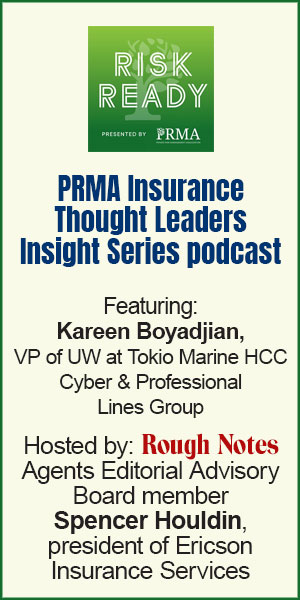Mind the Gap
By Marc McNulty, CIC, CRM
DANGER AHEAD! CERTIFICATE OF INSURANCE REQUESTS
Carefully vet requests and provide accurate information
Previous Mind the Gap columns have addressed specific problematic situations and explained how they can be remedied through insurance-based solutions that “fill in the gaps.” This month we’ll take a different approach and examine how your response to a simple request for a certificate of liability insurance can trigger a claim against your own errors and omissions (E&O) coverage.
Industry veterans will tell you that certificate requests are fraught with pitfalls. In contrast, those who are new to the industry may be eager to generate a certificate quickly and get it out to their client. After all, isn’t fast turnaround a sign of great customer service?
It is as long as you’ve crossed your t’s and dotted your i’s. Otherwise you may inadvertently create an E&O problem for yourself. Agents and service employees have lost their insurance licenses for issuing certificates that contain incorrect information.
Agents and service employees have lost their insurance licenses for issuing certificates that contain incorrect information.
Another problem is that your client, or the entity that has requested that your client provide a certificate, may not understand what they’re asking for.
In the case of producers, account managers, and customer service representatives, seasoned professionals are wise enough to scrutinize certificate requests with a fine-toothed comb. If the requested coverage isn’t currently in place, you should discuss the issue with your client. In some cases the request (and contract) can be modified. In other cases you will need to add endorsements to existing policies or recommend the purchase of additional policies.
Why it matters
The first line of the ACORD 25 Certificate of Liability Insurance reads: “This certificate is issued as a matter of information only and confers no rights upon the certificate holder.” The disclaimer goes on to state that the certificate does not affirmatively or negatively extend or alter coverage, nor does it constitute any kind of contract between the parties listed on the certificate.
Certificates are designed to represent a snapshot of an insured’s coverage at a certain point in time. Some entities that request certificates take matters into their own hands and request a bunch of extras, including the addition of language in the “Description of Operations/ Locations/Vehicles” section that shouldn’t be there.
This is a serious problem that can quickly get inexperienced professionals into hot water.
Here’s an example of a certificate request our agency received that clearly seeks to broaden the coverage in our client’s policies:
“XYZ Company, its subsidiaries, associated or allied companies, corporations, firms or organizations, their directors, officers, employees, partners, and agents are to be named as additional insureds on the General Liability, Auto Liability, and Pollution Liability (if applicable) policies.”
Do all these entities and individuals really need to have additional insured status extended to them? More important, does your client’s policy extend coverage to all of them?
Here are two more examples:
“The certificate must require 30-day advance notice to XYZ Company before the policy is cancelled for any reason,” and
“30-day written notice of cancellation applies.”
See a problem here? A 30-day advance notice for nonpayment of premium isn’t always possible, as many insurers offer only a 10-day notice. You might be able to get your carrier to extend the notice period, but don’t count on it.
Certificate requests also may specify waiver of subrogation and primary and noncontributory status.
Let’s circle back to why these requests can be dangerous when they aren’t fully vetted. If you indicate on a certificate that your client is providing additional insured status, waiver of subrogation, primary and noncontributory status, and/or a 30-day notice of cancellation, you’d better make sure your client’s policies actually contain these provisions. Otherwise you are misrepresenting its coverage; and if a claim triggers one or more of the provisions, your E&O could come into play.
Solutions
First, double-check each line item in the request against your client’s policy or policies—including limits. Don’t put something in the certificate that isn’t true, and don’t fudge the information simply to comply with the request.
For example, don’t list a lower limit of insurance than your client has in place. If it has a contract that calls for a $3 million umbrella policy but your client actually has a $5 million limit, list the correct limit.
Next, learn your carriers’ policy and endorsement language. Just because your client’s policy has an additional insured endorsement doesn’t mean it is the correct endorsement. Your client could enter into a contractual relationship with another entity that calls for a completely different additional insured endorsement than what is currently in place.
For example, suppose your contractor client needs to add the company for which it is performing work as an additional insured, along with the building owner, general contractor, architect, and bank. Let’s also assume the contract calls for completed operations coverage. If your client’s policy has only the CG 20 33 additional insured endorsement, it won’t be enough to satisfy these requirements. You’ll need to find a different additional insured form, be it an ISO version or a company-proprietary one.
Summing up
Tricky situations can quickly arise from the situations described above. Guidance can vary by insurer as well as by state. In Ohio we have been advised that it is best not to put anything in the “Description of Operations/ Locations/Vehicles” field unless asked; and, if asked, you must ensure that what is being requested is not illegal and that the information you enter does not misrepresent your client’s coverages and terms. My best advice is to consult your state’s insurance department to obtain its guidance on certificates.
When in doubt, check with your company underwriters to get their guidance in gray areas. Request them to respond via email and then save the response in case you need it in the future. It pays to have documentation in the event a claim goes sideways!
Certificates can be complicated as well as dangerous, so it’s worth taking the time to scrutinize each request and complete the certificate correctly. It’s in the best interest of your client as well as your agency to provide an accurate snapshot of your client’s insurance program in response to a certificate request.
The author
Marc McNulty, CIC, CRM, is vice president of insurance operations at The Uhl Agency in Dayton, Ohio, and has been with the agency since 2001. He divides his time among sales, marketing, technology and operational duties. You can reach Marc at marcmcnulty@uhlagency.com






